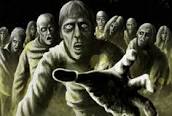Maria Dobrucka, nicknamed “Meva” (“seagull” in Polish), was
born in 1927 and grew up in Czortkow, a small Polish town in present-day Ukraine. Czortkow had a large Jewish population, and
by March of 1942 the Nazis had established a ghetto where all the Jewish
inhabitants---approximately 6,800 people---had to relocate to. And within six months, the Nazis had begun
shipping people from the ghetto to the concentration camp at Belzec.
It was around this time that the Hausers, a Jewish family,
got message to their friends the Dobruckas, begging them to help save their two
year-old daughter Inka Hauser.
Because of her size, it was decided that 15 year-old Meva
would sneak into the ghetto through a tiny window in the wall, get Inka, and
sneak back out. The plan seemed to have
little chance of succeeding, and if Meva had been caught she surely would have
been executed on the spot. Yet into the
ghetto she crept, at dusk on that August night in 1942 with a Star of David on
her arm in case Nazi soldiers spotted her.
Meva met the Hausers, took Inka in her arms, and climbed back out and
into the night undetected.
For the next three years, as the Nazi atrocities grew, and
roughly half of the Jews in the Czortkow ghetto were killed, Meva and the
Dobrucka family raised Inka. It would
have been more than heroic enough for teen-aged Meva to have the courage to sneak
in to the ghetto, get Inka, and sneak back out without the guards seeing
her. But the teen-ager also had the
compassion to continue comforting and caring for Inka as a sister for the
duration of the war.
In September of 1983 Maria Dobrucka-Mikusz, along with her
parents Aniela Dobrucka and Andrzej Dobrucki, was recognized as Righteous Among the Nations by Israel
for her heroism.
Miraculously, the Hausers survived, and after the war came
knocking on the Dobrucka’s door. Inka
did not recognize her parents at first because she had left them when she was
so young.
Now living in California with her own children, Inka
Hauser-Huber has remained in close contact with the woman who had literally
carried her through the valley of the shadow of death so many years before.
Maria “Meva”
Dobrucka-Mikusz is a hero you should know.
And I‘m Dr. Ross Porter.




















